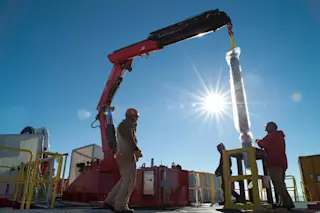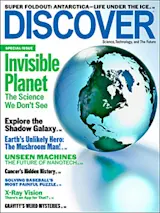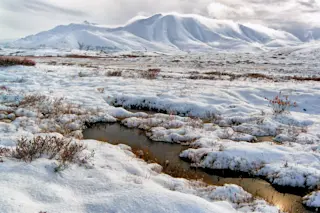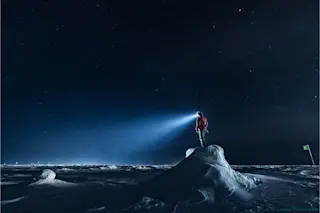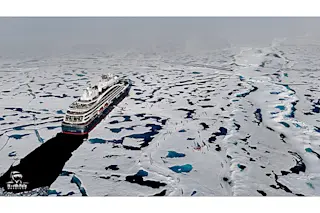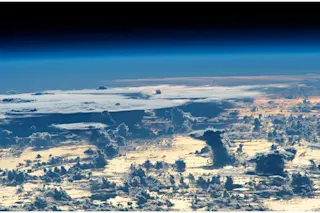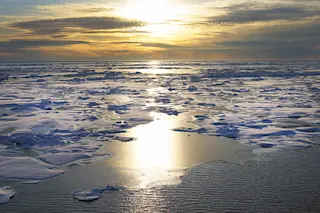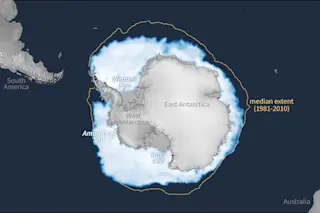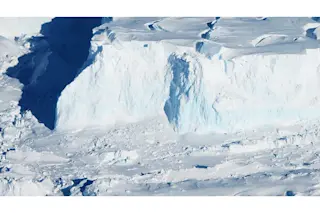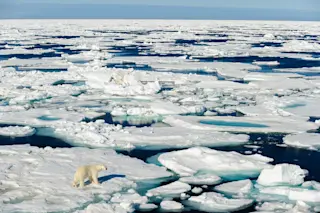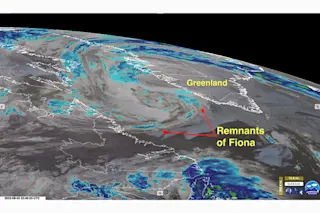Sunlight glared off of the Antarctic Ice Sheet. Slawek Tulaczyk, a 46-year-old glaciologist, squinted in the slanted summer rays as he watched a drama unfold 600 feet away.
A Hercules military cargo plane sat stranded, unable to take off. Its skis had frozen to the snow. The plane had just dropped off Tulaczyk along with 12 workers and 10,000 pounds of gear. They were here to probe one of the last unexplored places on Earth. Beneath the snow’s deceptively flat surface, under 2,600 feet of ice, lay a mysterious lake that human eyes had never seen. Tulaczyk, from the University of California in Santa Cruz, had waited six years for a chance to investigate this hidden body of water, called Subglacial Lake Whillans.
Now, as he watched the Herc make its second attempt to take off, he worried. Tulaczyk’s flight was the first to shuttle expedition scientists, engineers, technicians and gear to the field, and a stranded plane could prevent the rest of the crew and the last of the equipment from arriving in time.
The Herc’s four propellers roared, kicking up a blizzard of snow. The plane did not move.
Four men shoveled around the Herc’s skis, trying to free them. This cold-blooded butterfly could stay alighted on the ice sheet for only so long. If its engines were shut down for more than a few minutes, they might not restart in the cold.
Lake Whillans had likely not seen the light of day for hundreds of thousands of years, but Tulacyzk and the others who landed that day intended to see what was under the ice. They intended to drill into the lake and sample its water and mud. They intended to lower a camera into its belly. And they intended to find out what, if anything, might live there.
As Tulaczyk watched the Herc on Jan. 17, 2013, the lake remained a mere silhouette pieced together from noisy geophysical measurements involving radar, lasers shot down from satellites and the seismic echoes of shock waves released by explosives detonated in shallow holes in the ice.
But for scientists around the world, tapping into this humble lake had come to symbolize a major milestone in exploration. Almost 10 percent of the planet’s land area sits locked under glacial ice, where humans have never ventured. Exploring subglacial lakes could help answer many important questions: whether, for example, global warming might accelerate as Antarctica’s ice recedes. Sampling Lake Whillans could also provide hints about what kind of life might survive in icy worlds elsewhere in the solar system.
Getting into the lake represented a monumental task. A convoy of tractors had already towed 1.2 million pounds of drilling gear 600 miles from the coast of Antarctica, where McMurdo Station served as a base. Testing of the drill in McMurdo, and subsequent weather delays, had forced the expedition onto a critically tight schedule. Even as drilling was about to begin, the Antarctic summer and workable conditions were nearing an end — giving the team no more than 14 days. “Often fieldwork in this part of Antarctica is like trench warfare,” where you dig in and work for months, said Tulaczyk a few days before. “What we are trying to do is a blitzkrieg.”
Tulaczyk considered this as he watched the Herc rev its engines a third time. Its body shuddered. Its skis broke loose. The 125,000-pound plane lumbered forward, plowing the airstrip in both directions — a maneuver that lightened the plane’s load by incinerating several thousand pounds of fuel.
As the Herc traversed the skiway a fourth time, eight solid-fuel rockets mounted on its sides ignited, heaving the plane into the air.
Tulaczyk sighed with relief. The team’s goal lay tantalizingly close, only half a mile directly below. But, as the plane’s departure had showed, in these conditions even seemingly straightforward tasks, like melting a hole in the ice, often prove difficult.
Path to Exploration
The story leading to Lake Whillans extends back more than 50 years. For most of the 20th century, the Antarctic Ice Sheet was viewed as timeless, unchanging. A few scientists even suggested that nuclear waste be stored permanently inside it.
But in the latter half of the 20th century, a new technique, called ice-penetrating radar, allowed scientists to see through broad swaths of the ice and revealed entire buried mountain ranges, as tall as 9,000 feet. In the late 1960s and throughout the 1970s, Hercules aircraft with downward-looking radars flew thousands of miles of survey lines across the continent to map the subglacial landscape. This view changed the way scientists thought of Antarctica.
Glaciologists also noticed that, in some places, the ordinarily jagged landscape beneath the ice was perfectly flat and the radar reflection unusually bright — indicating water instead of rock.
People didn’t expect to find lakes under the ice, but today, over 200 are known to exist in Antarctica. The lakes are fed by geothermal heat that seeps up from the Earth’s interior, melting away the bottom of the ice sheet at a rate of several dime-thicknesses per year and liberating water from the ice.
In the mid-1990s, a lake containing 1,300 cubic miles of water (as much as Lake Michigan) was detected 12,000 feet below the surface of the ice in East Antarctica, beneath where the Russians had spent years drilling into the ice sheet to study its history. When the Russians’ drill came within 600 feet of the underlying lake, now called Lake Vostok, the ice that they were bringing up suddenly changed, from transparent to dirty, dotted with specks of mud. This dirty ice represented muddy water from Lake Vostok that had frozen back onto the bottom of the ice sheet.
John Priscu, a lake biologist from Montana State University in Bozeman, got his hands on a pound and a half of this dirty ice. Priscu had already found bacteria and algae thriving in small lakes along the coast of Antarctica. Only the upper 10 to 30 feet of water in these lakes was frozen as ice, so sunlight filtered through, allowing life to power itself through photosynthesis. But a lake as deeply buried as Vostok would be entirely dark, so any life there would have to use some other energy source.
At that time, the question of what life might inhabit Lake Vostok was becoming increasingly relevant to people who were looking for life elsewhere in the solar system. Space probes had found an ocean of water inside Jupiter’s moon Europa, locked beneath a shell of ice five to 10 miles thick. Scientists speculated whether life might inhabit that dark ocean — a breathtaking possibility, says Priscu, when you consider that the ice-covered oceans of Europa and other moons orbiting Jupiter and Saturn actually contain five to six times as much water as all the oceans on Earth. Lake Vostok was the perfect analog on Earth to investigate what life, if any, might survive in these sunless, extraterrestrial oceans.
Sure enough, Priscu found dead or dormant cells in the dirty Vostok ice — up to 600,000 per cubic inch. Skeptics speculated that the cells had come not from the ice itself but from the 100,000 pounds of kerosene drilling fluid that the Russians kept inside the borehole above Lake Vostok, to keep it from freezing shut. Priscu never got to sample Vostok directly to confirm his find because drilling the rest of the way into it was delayed. People feared that kerosene in the borehole would spill into the pristine lake when it was finally penetrated.
By 2007, though, another plan was taking shape. Satellite measurements had just revealed the existence of Lake Whillans under half a mile of ice in West Antarctica. The lake was 7.5 miles long, 5 miles wide and 25 feet deep.
Tulaczyk became the first researcher to visit Lake Whillans in November 2007. A glaciologist rather than a biologist, he wanted to investigate a question critical to climate change: Do subglacial rivers and lakes lubricate the movement of ice over land — and might they somehow accelerate a glacier’s flow into the ocean, triggering rapid sea level rise?
Tulaczyk’s team installed instruments on the ice surface above Lake Whillans to monitor movement of the ice sheet. (Read Douglas Fox's story about this research expedition in "The Ground Zero of Climate Change," DISCOVER, September 2008.)
That expedition was an important first step, but understanding the physics and biology of Lake Whillans would ultimately require drilling into it. Tulaczyk, Priscu and dozens of other scientists made plans. They would bore through the ice with a jet of hot water instead of a metal drill surrounded by kerosene.
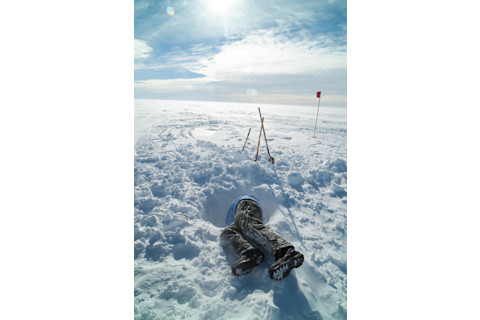
Graduate student Grace Barcheck, from the University of California in Santa Cruz, buries a seismic sensor in the ice sheet above Subglacial Lake Whillans. | JT Thomas
Hot water drilling still posed challenges: A borehole filled with water would quickly refreeze, and the hole could still collapse shut under the sheer weight of the surrounding ice sheet. The National Science Foundation funded the ambitious project, and starting in November 2012, more than 30 scientists, drillers and technicians made their way to McMurdo Station on the coast to prepare for their push to Lake Whillans. The group included separate teams of biologists, geologists and glaciologists from a dozen institutions. Several flights in January 2013 would transport them and some scientific instruments (too fragile to be towed in the convoy) from McMurdo to Lake Whillans.
The first flight, the one carrying Tulaczyk, finally landed at Lake Whillans on Jan. 17; due to weather, it was 13 days later than planned. Such delays, together with uncertainties about how quickly drilling would go, increased the chances that the lake wouldn’t be reached, or that efforts to sample it would be crippled. But over the next five days, three more flights managed to deliver most of the remaining scientists and gear. All that remained was the task of boring through the ice and keeping the narrow, ephemeral portal open for several days.
Into the Abyss
Whillans drill camp sits 380 miles from the South Pole, a constellation of faint dots nearly invisible through the membrane of mist that often cloaks West Antarctica during the summer. Up close, the camp is industrial in scale.
Each dot represents a truck-size shipping container welded onto a massive sled. The drill comprises a dozen of these sleds, arranged end to end like a segmented, metallic organism. Segments one, two and three, at the head of the beast, house generators and transformers that convert jet fuel into 450,000 watts of electricity. In segment four, water (from melted snow) is sterilized using ultraviolet radiation and filtration. The water then flows through woven Kevlar-reinforced hoses to segments five and six, where it is heated and pressurized. Then in segment seven, the water enters a section of hose more than half a mile long, coiled around a spool as wide as a school bus. As drilling began on Jan. 23, the hose was gradually unspooled into a hole in the ice sheet. Hot water gushed from the nozzle.
This machine was built by seven ice drillers from the University of Nebraska in Lincoln: a motley crew of college-educated guys who fled the reliable monotony of NASA or biomedical engineering jobs in search of adventure. Dressed in battered Carhartt overalls and grease-stained gloves, they operate the drill, patrolling its far-flung appendages on foot, communicating by handheld radios as they turn valves to adjust the flow of water.
“You just want to keep everything warm and moving as much as you can,” said driller Dar Gibson, a former meteorologist, one night as the drill was halted for repairs. Shutting down is a race against time: Slowdowns can cause clots of ice to form in hoses, the mechanical equivalent of a blocked coronary artery.
At 6:30 p.m. Jan. 25, after two days of drilling, the final approach into Lake Whillans began. The drill hose dangled 2,480 feet down a 20-inch-wide hole in the ice. The lead driller, Dennis Duling, a 61-year-old former farmer with a gray beard, sat in the control room, his calloused hand on a mouse, surveying sensor readings on a computer. Those readings encompassed his secondhand knowledge of the world half a mile below — a world he must navigate by feel rather than sight.
Because of harsh conditions in the borehole, Duling and his men have no camera on the drill itself. They must infer what is happening thousands of feet below using proxy measurements from three sensors. One sensor counts the revolutions on the spool reeling out the drill hose (this data is used to estimate the depth of the hole); another sensor measures the weight of the dangling hose, revealing if the hose goes slack because it has bumped against an obstruction; a third sensor monitors pressure and detects if the water level in the hole rises or falls — potential evidence that the lake has been reached.
Eying this data from the sensors, Duling ordered the drilling slowed to a crawl, worrying that they were nearing the lake and trying to avoid stirring up mud. “We don’t want to blast our way in,” he said. On the night of Jan. 25, no one knew at what exact depth they would break through. It would become a vexing question.
Breaking the Surface
The drill appeared to break into the lake at 12:10 a.m. Jan. 26; the hose was pulled up so a camera could be lowered down the hole to confirm the break-in. Unfortunately, that camera never reached the bottom: At 2,300 feet, the hole split into two branches, preventing the camera from being guided deeper.
The camera was withdrawn from the hole and the drill hose lowered down to the point of the branch. Hot water was pumped in with the goal of melting the branch into a single, wide passage through which the camera could later be lowered.
At 7 p.m. Jan. 26, the camera was lowered a second time. People crowded into the control room to watch the live feed. The camera encountered the same branch at 2,300 feet; the hot water drill had failed to solve the problem. This time, though, in a lucky break, the camera was successfully jostled down past the intersection. People in the control room cheered.
The camera eased down 50 feet. The hole expanded, contracted, then widened again. Then the camera came to rest. A second or two passed before people understood what they were seeing.
The camera lay on a floor of white. Of ice. The hole had dead-ended. “Holy cow,” said someone, in disappointment.
The drillers soon figured out the problem. A sensor on the drill hose wasn’t calibrated properly and had overestimated the length of hose fed into the hole. The drill was stopped at least 100 feet short of the lake.
“When you come down here, you get your nose bloodied up,” said Duling. “It’s all right. We can handle it.” He appeared tired, resigned. “We will drill one more time.”
Twenty-four hours later, on Jan. 27, a banter of dry gallows humor circulated among the drillers. “You guys want to watch Thelma and Louise?” crackled one of them over the radio, a dude with a heavy wrench and thick beard deflecting feelings of anxiety with a chick-flick reference.
“Only if we can hold hands and cry,” replied Gibson into his handheld. Gibson sat in the control room, where people gathered to see the camera descend a third time down the hole, after another round of drilling.
The camera passed 1,600 feet. Undulations in the hole’s circular walls scrolled over the monitor like contours of a cosmic wormhole. Then, the image dissolved in haze. All sense of motion ceased.
A conversation sprang up in the dark room. Was the water cloudy, or had the camera malfunctioned? “Are we still going down?” Gibson asked into his radio.
“We are,” crackled the reply. “Just coming up on 640 meters [2,100 feet].”
Minutes trickled past. The blur on the monitor darkened to brown. Cable “just went slack,” crackled the radio. “We just hit the bottom.” The camera rested 2,626 feet below.
Swirling silt settled. A view of the lake coalesced.
The camera lay on its side, its lens gazing across a muddy floor strewn with clumps. Wisps of mud drifted in the water. The image, knitted in rows of grainy pixels, echoed the first-ever pictures of the Martian surface beamed back by the Viking lander 36 years ago — an image of a place never before seen by humankind.
Contrary to expectations, the water itself was only 5 feet deep, not 25 feet. Radar surveys had overestimated the lake’s depth by mistaking 20 feet of gooey mud forming the lake bed for water, said Tulaczyk during a hastily called meeting. “This lake is old enough to have filled with sediments for the most part.” Notwithstanding that surprise, the team would finally have a chance to look for life beneath the ice sheet.
At 6:20 a.m. Jan. 28, half a dozen people in sterile white suits gathered at the drill platform, awaiting the first sample of Lake Whillans water.
A taut cable inched out of the borehole. Brent Christner, a microbiologist from Louisiana State University, chipped globs of frost off the cable with a hammer. An opaque bottle rose into view. Priscu carried it into a laboratory. People crowded in as the first water from Subglacial Lake Whillans was decanted into a clear tube.
The liquid was honey-colored. An electrode was dipped in — a number flashed onto an LCD. The water conducted electricity strongly, evidence that it was laden with mineral salts that could serve as food for microbes. A whoop of excitement went up.
The Search for Life
The subglacial environment is often described as extreme. But Lake Whillans has turned out to be surprisingly hospitable.
The lake registered at just 31 degrees Fahrenheit, slightly warmer than the coastal seas near McMurdo Station, which teem with sea stars, 100-pound toothfish and other living things. Pressure from the ice sheet overhead keeps the subglacial water liquid by lowering its freezing point several degrees.
Lake Whillans also contains oxygen, which is injected into the subglacial space by air bubbles released as the ice sheet melts. It would be enough oxygen, in some cases, to support worms, starfish and other marine invertebrates on the seafloor.
The spot where Lake Whillans sits today was once a shallow seafloor. Reed Scherer, a marine micropaleontologist from Northern Illinois University, saw evidence of this when he smeared mud from the lake onto a glass slide.
Scherer placed the slide under a microscope and twisted a knob. A glassy object snapped into focus — a round disk, serrated on the edge, perforated with dimples — the shell of an aquatic microscopic organism called a diatom. “Probably Miocene,” he said. “Likely 10 to 15 million years old.” The slide contained around a hundred crushed diatom shells.
What is now Lake Whillans was probably covered and uncovered by the ice sheet dozens of times as the climate swung back and forth over the past 20 million years. The ice most recently rolled over the lake sometime between 120,000 and a million years ago, depending on which of several warming episodes the ice sheet did or didn’t withstand. Any life that exists in the lake today may represent hangers-on from its ice-free time.
But any survivors needed to overcome a major challenge. The ice cut off sunlight and photosynthesis — the main source of energy for most ecosystems on Earth’s surface. So subglacial life, if present, would have to power itself through the chemical breakdown of minerals instead.
The honey color of that first sample of Whillans water provided a hint: a sign of tiny mineral grains (pulverized by glaciers), some smaller than a red blood cell. That glacial grinding turned the minerals into good microbe food, much as the milling of wheat into flour makes it more digestible to humans.
On Jan. 28, Trista Vick-Majors, one of Priscu’s Ph.D. students, took a long-awaited step: She added DNA-sensitive dye to a sample of lake water — the first attempt to detect life in Lake Whillans. As she viewed it through a microscope, she saw specks of green shining against a background of black — cells glowing in response to the dye — as many as 1.6 million cells in each cubic inch of water. Those cells were the first ever found unambiguously in a subglacial lake.
A Balancing Act
A portrait of life beneath Antarctica’s ice will take time to emerge. Louisiana State University microbiologist Christner is using DNA sequencing to census hundreds of microbe species from the lake. It will provide a glimpse of what taxonomic groups they belong to.
Christner’s and Priscu’s teams are also growing microbes from more than 500 cultures collected from the lake. “We may be coming up with cultures that people study for the next 50 years,” says Christner.
Understanding microbial life and the mineral breakdown that it incites under the ice sheet could help answer some momentous questions about whether global warming will speed up as Antarctica’s ice recedes. Some scientists believe that microbes under the ice may have produced billions of tons of methane — a potent greenhouse gas that could escape as the ice retreats, causing warming to accelerate.
On Feb. 1, Tulaczyk and his students made one last use of the borehole. They lowered a string of vibration sensors into it. The bottom sensor hung 60 feet above the lake. Those sensors, which the ice would encroach on and eventually envelop, would document the private life of Lake Whillans over time, recording rumbles of turbulence and tumbling rocks as currents washed through the lake. This information would help Tulaczyk understand whether subglacial water lubricates the flow of ice, and whether it might play a role in the runaway acceleration of glaciers that has occurred in some parts of Antarctica. The hole was covered in plywood, and snow piled on top.
A mile west stood 21 squat silhouettes, backlit in the afternoon sun. The team had bulldozed these snow platforms into existence. Twenty sleds and 700,000 pounds of gear would soon be parked atop them for winter, safe above the snowdrifts that would unfurl for half a mile in their wakes.
As winter darkness falls and the mercury drops to 50 degrees below zero, those parked sleds remain a gesture of hope: If budgets allow, Tulaczyk and Priscu will return next year, drill more holes and continue exploring Antarctica’s hidden world.


